Isolation Methods
Maintaining a variety’s unique traits is vital in the practice of seed saving, and isolation is one of the key facets.
Maintaining a variety’s unique traits is vital in the practice of seed saving, and isolation is one of three key facets (along with population-size management and selection) needed to successfully save seeds that are true to type. Keeping plants of the same species separated prevents cross-pollination and thus keeps seeds collected from open-pollinated varieties true-to-type. Isolation by distance is the most fail-proof way to prevent cross-pollination between two varieties of the same species, but you can get creative when required isolation distances are not feasible.
You can manage isolation through several methods—by distance, by containment, or by timing of flowering. Isolation by distance—which involves providing enough distance between a variety and any sources of contaminating pollen to ensure that the variety remains true to type—is the most reliable method. The isolation distance required for effectively preventing cross-pollination depends largely on the mating system of a species and can range from 10 feet for primarily self-pollinating grains, such as oats, to several miles for cross-pollinating crops, such as spinach.
Unwanted pollen can come from various sources. Most commonly, it comes from other varieties of the same species being grown in close proximity—including plants in your own garden, in neighboring gardens, or on nearby farms. Another less frequent source of unwanted cross-pollination (though it can be significant for certain species) is pollen from wild plants—native or naturalized—of the same species or a species that is cross-compatible with the one being grown for seed. Keep in mind that plants exchange pollen only during flowering, and isolation is required only when two or more compatible varieties are flowering at the same time.
As a general rule, plants that primarily self-pollinate require less isolation distance, while plants that primarily cross-pollinate require greater distances. Wind-pollinated crops, such as spinach and beets, have very fine, lightweight pollen that is easily carried a great distance on air currents, often making the isolation distance for a wind-pollinated species quite long. Insect-pollinated crops may require somewhat less distance between varieties than wind-pollinated crops because insects often gather nectar and pollen within limited areas.
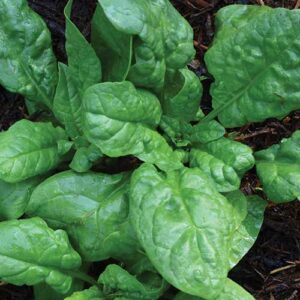
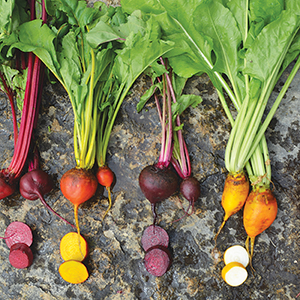
Other factors that influence how widely pollen spreads (and the likelihood of cross-pollination) include prevailing wind direction, topography, size of plantings, and local insect populations. It is important to consider not only the overall placement of plants in the landscape in relation to other cross-compatible populations but also the size of both populations. The more plants of a variety, the greater the likelihood that errant pollen, either carried on the wind or by a pollinator, will find its way into the population as a whole. Similarly, the more plants of the same species that are in the greater landscape—either as wild plants, in neighboring gardens, or in large stands of nearby agricultural fields—the more cross-compatible pollen there is to contend with and the greater the risk that unwanted cross-pollination will occur.
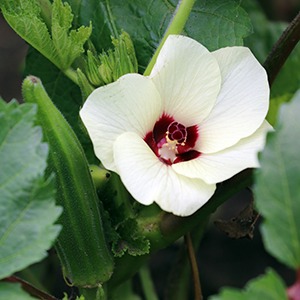 Often, you can effectively achieve isolation by distance by saving seeds from only one variety of a species at a time. If the crop is normally cultivated for its edible fruits or seeds—such as with melons, okra, or sunflowers—then saving seeds from one variety means growing only one variety. If the crop is typically harvested prior to entering the reproductive phase, such as with turnips or Swiss chard, multiple varieties can be grown in the same garden, provided measures are taken to ensure that only one variety is allowed to flower and set seeds. This approach assumes that contaminating pollen will not travel in from surrounding gardens or farms, and so is feasible only when gardeners can eliminate the possibility of unwanted cross-pollination with plants in neighboring gardens or the landscape. Given that the seeds of many vegetable species can remain viable for years, saving seeds from one variety within a species at a time is a reasonable approach. In other words, a favorite cabbage variety can be saved one season, and a broccoli cultivar the next.
Often, you can effectively achieve isolation by distance by saving seeds from only one variety of a species at a time. If the crop is normally cultivated for its edible fruits or seeds—such as with melons, okra, or sunflowers—then saving seeds from one variety means growing only one variety. If the crop is typically harvested prior to entering the reproductive phase, such as with turnips or Swiss chard, multiple varieties can be grown in the same garden, provided measures are taken to ensure that only one variety is allowed to flower and set seeds. This approach assumes that contaminating pollen will not travel in from surrounding gardens or farms, and so is feasible only when gardeners can eliminate the possibility of unwanted cross-pollination with plants in neighboring gardens or the landscape. Given that the seeds of many vegetable species can remain viable for years, saving seeds from one variety within a species at a time is a reasonable approach. In other words, a favorite cabbage variety can be saved one season, and a broccoli cultivar the next.
The recommendation for each species reflects a range of isolation distances used by seed savers to successfully produce true-to-type seeds in home gardens, although there is no guarantee that cross-pollination will be avoided even at the high end of the range. Every garden—and every planting—is different; the range of recommended isolation distances reflects the fact that environmental conditions, landscape features, pollinator populations, and sizes of plant populations all interact and influence how far pollen may travel.
Seed Saving Guide: Isolation recommendations by crop type
Recommended isolation distances are intended as general guidelines; each seed saver will need to experiment to find isolation distances that prove sufficient within their unique garden environment. For some this may be closer than the shortest distance stated, while for others the actual isolation distance required may exceed the high end of the recommendation. Increasing isolation distances will always decrease the risk of cross-pollination between varieties. The upper end of the recommended range may be a more appropriate starting place if you are planning on sharing your seeds (we recommend The Exchange!) or gardening in a setting that lacks distractions or barriers.
When space is limited and isolation by distance is not possible, you can physically isolate insect-pollinated plants from each other through the use of isolation tents or blossom bags, as well as by physical or landscape features. Growing insect-pollinated plants inside tents with introduced pollinators prevents cross-pollination. Isolation by containment cannot be used on wind-pollinated crops like corn or beets, as physical barriers can keep insects out, but allows pollen carried by the wind to enter and cross-pollinate these crops.
 Though often used by larger-scale growers, isolation tents/cages can be more challenging for home growers because pollinators are typically purchased and then introduced inside the cages. Another approach to utilizing isolation tents is known as alternate-day caging. This method involves moving isolation cages between two different varieties in the same species on alternating days to prevent them from cross-pollinating, while still providing them with access to pollinators on the days that they’re not covered. Once fruit is set, you don’t need the plants to have access to pollinators, so you can leave them caged. (Note: You don’t need fancy supplies to make an isolation tent; you can make one yourself using mosquito netting and posts, which helps keep the netting off of the plants.) Finally, blossom bags are exactly what they sound like—placing a bag made from quick-drying, permeable material over individual flowers or flowering branches. Crop types that can be easily blossom-bagged include eggplants, peppers, and tomatoes.
Though often used by larger-scale growers, isolation tents/cages can be more challenging for home growers because pollinators are typically purchased and then introduced inside the cages. Another approach to utilizing isolation tents is known as alternate-day caging. This method involves moving isolation cages between two different varieties in the same species on alternating days to prevent them from cross-pollinating, while still providing them with access to pollinators on the days that they’re not covered. Once fruit is set, you don’t need the plants to have access to pollinators, so you can leave them caged. (Note: You don’t need fancy supplies to make an isolation tent; you can make one yourself using mosquito netting and posts, which helps keep the netting off of the plants.) Finally, blossom bags are exactly what they sound like—placing a bag made from quick-drying, permeable material over individual flowers or flowering branches. Crop types that can be easily blossom-bagged include eggplants, peppers, and tomatoes.
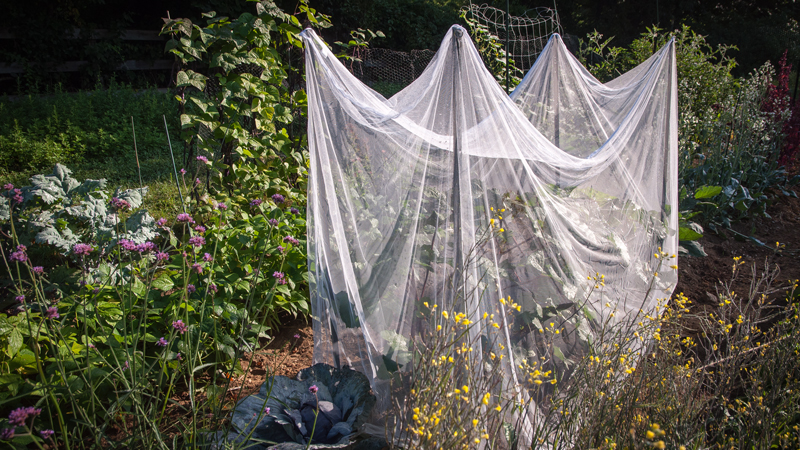
Physical barriers and landscape features—such as buildings, stockade fences, tree lines, and shrub hedges—affect how pollen moves through the landscape and may hinder the flow of wind-borne pollen. They may also impact the travel patterns of insect pollinators. Some seed savers plant different varieties of the same species on opposite sides of their property, believing that if the two plants are not in view of each other, it is unlikely for an insect to travel between them without stopping along the way and randomly dispersing the pollen it is carrying.
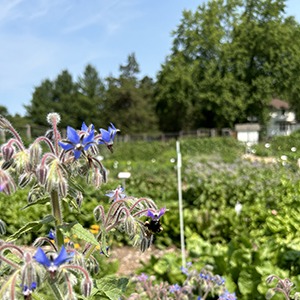 Growing other flowering plants between two varieties of the same species that are in bloom at the same time may distract pollinators and prevent them from traveling from one variety directly to the other, in effect minimizing unwanted cross-pollination.
Growing other flowering plants between two varieties of the same species that are in bloom at the same time may distract pollinators and prevent them from traveling from one variety directly to the other, in effect minimizing unwanted cross-pollination.
Additionally, dense plantings of nectar- and pollen-rich flowers growing between different varieties of the same species may distract pollinators and prevent them from making unwanted crosses. However, while barriers and distractions help minimize pollen dispersal within a garden, they are not guaranteed isolation methods. They only help to decrease the probability of unwanted cross-pollination and may allow for a reduction of isolation distances.
You can also plant varieties in sequence so that their flowering times don’t overlap, although we recommend using this method only with crops, such as corn, that have a short and uniform flowering time, as timing is difficult to coordinate. Stagger plantings of different varieties of corn in order to save seeds from multiple varieties in the same season.
Crops that are isolated to prevent cross-pollination still require pollination to successfully set seeds. Because of this, you can pollinate plants by hand to take the place of the insect pollinators. This can be easily practiced with crops like corn and squash; however, hand pollination is generally not practiced on larger-scale gardens/farms because it’s quite time-intensive.
Learn How to Hand-Pollinate Squash
Shop and Learn More
Shop seed-saving tools like blossom, corn, lettuce bags, and more, or continue your seed saving education.